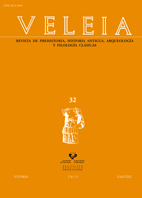Another look at the transliteration of the tartessian (or south-lusitanian) monumental script
##plugins.themes.bootstrap3.article.main##
##plugins.themes.bootstrap3.article.sidebar##
Abstract
This paper revises some particular questions regarding the reading of the script in the steles called Tartessian in light of recent epigraphic discoveries. Four main points are suggested: 1) revision of the Algarvian variant of the script, specifically on the use of signs in the shape of «heth» for the letter ta; 2) new support for my proposal on the reading of ku and pu; 3) new evidence for the existence of a fourth sign connected to the vowel u; 4) revision of the problem of whether there was or not some method of notation of the phoneme /m/ in the script, taking into account the signs similar to both the n and the Greek 'my', as well as the possible digraphical value of the groups np to represent either /m/ or another sound.
Downloads
##plugins.themes.bootstrap3.article.details##
Almagro-Gorbea, M., 2008, «Medellín-Conisturgis: Reinterpretación Geográfica del Suroeste de Iberia», Boletim da Sociedade de Geografia de Lisboa, serie 126.ª, n.º 1-12, 84-115.
Aubet Semmler, M.ª E., 1987, Tiro y las colonias fenicias de Occiente, Bellaterra.
Aubet Semmler, M.ª E., 1994, Tiro y las colonias fenicias de Occiente. Edición ampliada y puesta al día, Barcelona. Correa, J. A., 1987, «El signario tartesio», Veleia 2-3, 275-284.
Aubet Semmler, M.ª E., 1989, «El origen de la escritura paleohispánica» en: J. González (ed.), Estudios sobre Urso, Sevilla, 281-302.
Aubet Semmler, M.ª E., 1990, «La epigrafía del Suroeste», Arqueologia Hoje 1. Etno-Arqueologia, 132-143.
Aubet Semmler, M.ª E., 1992, «La epigrafía tartesia» en: J. Untermann, D. Hertel (eds.), Andalusien zwischen Vorgeschichte und Mittelalter 'Forum Ibero-Americanum' 7, Köln, 75-114.
Aubet Semmler, M.ª E., 2002, «La distribución de las oclusivas orales en la toponimia prerromana de la Bética», Palaeohispanica 2, 133-139.
Correia, V. H., 1996, A epigrafia da Idade do Ferro do Sudoeste da Peninsula Ibérica, Porto.
García-Bellido, M.ª P., 2013, «¿Clerujías cartaginesas en Hispania? El caso de Lascuta», Palaeohispanica 13, 301-322.
Guerra, A., 2002, «Novos documentos epigrafados com escrita do Sudoeste da vertente setentrional da Serra do Caldeirao», RPA 5/2, 219-231.
Guerra, A., 2013, «Algumas questões sobre as escritas pré-romanas do Sudoeste hispânico», Palaeohispanica 13, 323-345.
Guerra, A. et alii, 1999, «Uma estela epigrafada da Idade do Ferro, proveniente do Monte Novo do Castelinho (Almodoˆvar)», RPA 2/1, 143-152.
De Hoz, J., 1985, «El origen de la escritura del S.O.» en: Actas del III Coloquio sobre Lenguas y Culturas Paleohispánicas, Salamanca, 423-464.
De Hoz, J., 1989, «El desarrollo de la escritura y las lenguas en la zona meridional», en: M.ª E. Aubet (ed.), Tartessos. Arqueología protohistórica del Bajo Guadalquivir, 523-587.
De Hoz, J., 1990, «El origen oriental de las antiguas escrituras hispanas y el desarrollo de la escritura del Algarve», en: Presenças Orientalizantes no Território Português até à Epoca Romana, Lisboa, 219-246.
De Hoz, J., 2010, Historia lingüística de la Península Ibérica en la Antigüedad. I. Preliminares y mundo meridional prerromano, CSIC, Madrid.
Jagersma, A., 2000, «Sound change in Sumerian: the so-called /dr/-phoneme», Acta Sumerologica 22, 81-87.
Koch J.T., 2011, Tartessian 2, Aberystwyth.
Krahmalkov, Ch., 2001, A Phoenician-Punic Grammar, Leiden. Laver, J., 1994, Principles of Phonetics, CUP Melbourne.
Loprieno, A., 1995, Ancient Egyptian. A linguistic introduction, CUP, Melbourne.
Mikhailova, T. A., 2010, «J.T. Koch. Tartessian: Celtic in the South-West at the Dawn of history (Celtic Studies Publication XIII). Aberystwyth: Centre for advanced Welsh and Celtic studies, 2009», Вопросы языкознания 3, 140-145.
Rodríguez Ramos, J., 1992, [inédito]: Análisis de Epigrafía Sudlusitana, tesis de licenciatura, Universidad de Barcelona.
Rodríguez Ramos, J., 2000a, «La lectura de las inscripciones sudlusitano-tartesias», Faventia 22/1, 21-48.
Rodríguez Ramos, J., 2000b, «Sobre la geminación gráfica de signos vocálicos en la escritura sudlusitano-tartesia», Veleia 17, 147-152.
Rodríguez Ramos, J., 2001, «La cultura ibérica desde la perspectiva de la epigrafía: un ensayo de síntesis», Iberia 4, 17-38.
Rodríguez Ramos, J., 2002a, «Las inscripciones sudlusitano-tartesias, su función, lengua y contexto socio-económico», Complutum 13, 85-95.
Rodríguez Ramos, J., 2002b, «El origen de la escritura sudlusitano-tartesia y la formación de alfabetos a partir de alefatos», RStFen XXX,2, 187-222.
Rodríguez Ramos, J., 2004, Análisis de Epigrafía Íbera [Anejos de Veleia. Series Minor 22], Vitoria-Gasteiz.
Rodríguez Ramos, J., 2005-2009, «La lengua sudlusitana», Studia Indogermanica Łodziensia VI, 83-108.
Sáez Fernández, P., 1990, «Estudio sobre una inscripcion catastral colindante con Lacimurga», Habis 21, 205-227.
Schmoll, U., 1961, Die südlusitanischen Inschriften, Wiesbaden.
Toscano Pérez, C., Correa Rodríguez, J. A., 2014, «Grafitos tartesios hallados en Niebla (Huelva) y su contexto arqueológico», Onoba 2, 45-54.
Untermann, J., 1997, Monumenta Linguarum Hispanicarum. Bd. IV, Die tartessischen, keltiberischen und lusitanischen Inschriften, Wiesbaden.
Valerio, M., 2008, «Origin and development of the Paleohispanic scripts: The Orthography and Phonology of the Southwestern Alphabet», RAP 11/2, 107-138.
Unless otherwise noted, the contents of the electronic edition of the OJS platform are licensed for use and distribution under a Creative Commons Attribution-NonCommercial-NoDerivatives 4.0 International (CC-BY-NC-ND) license.
The journal does not charge any financial compensation to authors for publishing in it and provides full access to the archives without any kind of embargo from the day of electronic publication. This respects the national open access policy.
All originals published in the journal Veleia, whether in print or digital format, are the property of the University of the Basque Country (UPV/EHU). © UPV/EHU
Authors of articles (whether research articles, news articles, news items or reviews) will be able to access their own work on the Journal's website. Authors will be able to put them in their personal repositories and will also have the possibility of pre-print dissemination of articles accepted for publication.

